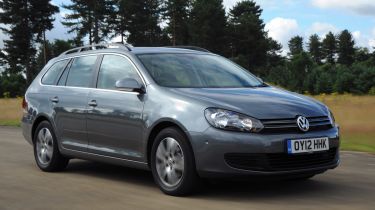Volkswagen Golf Estate
Traditional estate is still a top-quality product
While Hyundai and Renault have ditched the estate badge for more lifestyle-friendly names like Tourer and Sport Tourer, Volkswagen has no such insecurities over its dependable Golf.
And despite being the oldest car in the test, the Golf Estate still looks good. The front end has the same classy appearance as the hatch, while chrome trim highlights the extended window line. SE models get black roof rails, but for £120 you can go for more upmarket silver versions. Unfortunately, slightly uninspiring tail-lights make the car least attractive from the rear.
Climb aboard, and the VW wins you over. Cabin quality has always been one of the car’s biggest selling points, and that hasn’t changed. Hyundai’s huge advances mean there’s no longer a gulf of difference when it comes to quality, but the Golf still has a premium feel.
The layout is less complicated than the Renault’s, and the driving position is perfect. The deep-set dials are easy to read and all the controls are nicely weighted. Our car came with an optional multifunction leather steering wheel and touchscreen navigation, but cruise control and the black dash inserts are standard in this classy cabin.
The Golf isn’t just about quality, however, as it provides enough space to be a useful estate car. Rear passenger room is a match for the newer Hyundai, although a slightly larger transmission tunnel means there’s not as much foot space for those in the middle seat.
Used - available now

2019 Ford
Kuga
59,138 milesManualPetrol1.5L
Cash £11,165
2022 Vauxhall
Corsa
8,874 milesManualPetrol1.2L
Cash £12,332
2019 Peugeot
2008
21,846 milesManualPetrol1.2L
Cash £11,049
2018 Dacia
Logan MCV
42,276 milesManualDiesel1.5L
Cash £7,197With the rear seats in place, the 505-litre boot is 23 litres smaller than the Hyundai’s, and the Golf has the narrowest gap between the wheelarches. But there’s a 1,710mm maximum load length, so the car will still carry a full-size bicycle with ease.
On top of that, the boot features an array of useful bag hooks and underfloor storage, plus it’s the only car to get a load-through ski hatch as standard. There are even neat sliding trays under the front seats.
The Golf struggles on ultimate volume, though. While the rear seats fold flat, its 1,495-litre capacity trails the i30’s by 147 litres. Even the Renault has a 105-litre advantage.
Power comes from VW’s tried and tested 1.6 TDI diesel, which thanks to BlueMotion Technology emits just 109g/km – making the car a fraction cleaner than the Hyundai.
However, it isn’t as refined, and with 10Nm less torque – at 250Nm – it’s not as responsive as the i30. Real-world pace is further blunted by the long ratios of the five-speed transmission, which forces you to constantly change gear to keep the engine in its narrow powerband.
Still, we averaged 45.4mpg, and the Golf is quiet and comfortable at speed. It’s reassuringly composed in corners, too. Weighty steering and lots of grip combine with decent body control to make the car very easy to drive. It’s not as firm as the Renault and better controlled than the Hyundai, and an accomplished ride wraps up a polished dynamic set-up.
Strong residuals and fixed-price servicing go some way to balancing out the price gap to its cheaper and better equipped rivals here.
Details
Chart position: 3Why? Our current favourite is the benchmark for desirability and quality. With the 1.6 TDI BlueMotion Technology diesel, it’s clean, too.







